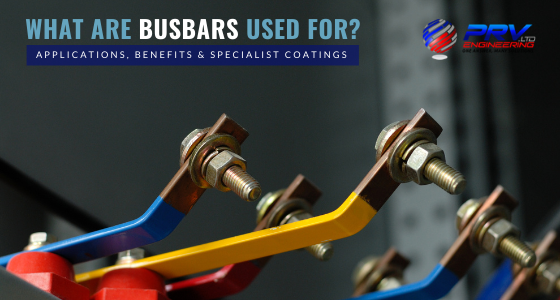Busbars (also referred to as bus bar) are fascinating feats of engineering making complex power distribution simpler, more affordable and flexible. The main purpose of busbars is to conduct a substantial current of electricity and are typically housed inside switchgear, panel boards or busways.
Rather than branching the main supply at one location, busbars allow new circuits to branch off anywhere along the route of the busway. A busbar is used to connect high voltage equipment at electrical switchyards, and low voltage equipment in battery banks but also prominent in the automotive and defence sectors.
How Do Busbars Work?
Electrical busbars are conductors or a group of conductors used for collecting electric power from incoming feeders. From there, they distribute the power to the outgoing feeders. In laymen’s terms, it is a type of electrical junction where all incoming and outgoing electrical currents meet. The bus bar system has an isolator and the circuit breaker which works as follows. In the event of a fault, the circuit breaker trips and the faulty section of the busbar is easily disconnected from the circuit.
Related: ‘PRV Engineering and the Rail Industry‘
Applications Of Busbars
Busbars are produced in a variety of shapes, such as flat strips, solid bars, or rods. They are typically composed of copper, brass or aluminium as solid or hollow tubes. When space is limited or alternative electrical distribution is required, busbars are the go-to for many industries.
We look at two types of busbars – laminated and flexible with both serving a multitude of sectors. Laminated busbars are widely used in the following applications:
- Cellular communication systems
- Telephone exchange systems
- Power and hybrid traction
- Base stations
- Power switch systems
- Large network equipment
- Military equipment systems
- Power generation systems
- Power conversion modules of electric equipment
Flexible busbars are used in:
- Electric, Hybrid and Fuel Cell vehicles
- Electrical connections in switching cabinets
- Power link for generators
- Transformers and charging stations
Benefits Of Using Busbars
Busbars have several benefits and are crucial in electrical distribution systems. This is especially the case when simplifying the process of electrical power distribution, reducing overall cost while allowing for greater flexibility. Here is a brief breakdown of the primary benefits of busbars.
Busbars may be more expensive than a wiring harness but they last longer and don’t require regular replacement. They distribute power more efficiently, thus, reducing energy consumption which is particularly important for many 21st century businesses.
They’re also easily adaptable for renewable energy integration while offering extreme versatility for easy customisation for many purposes. Busbars can withstand external weather conditions well, making them the perfect solution for electrical substations or switchyards. Even with costly installation, busbars are a cost-effective solution, especially when developing a new system.
Why Are Busbars Coated?
The type of material and the shape or size of the busbar will determine the ‘ampacity’. Plating a bus bar with tin or silver provides a coating over the surface to help protect against oxidisation. This will not completely prevent oxidising over long periods, however, it can dramatically reduce the effects.
Copper coated busbars, for example, are particularly durable and exceptionally good conductors with a high threshold from damage due to high temperatures. When they are not plated, the surface will oxidise over time and will lose conductivity compared to a smooth or plated surface.

In terms of silver coating, it has the highest electrical and thermal conductivity with the lowest contact resistance. This means it’s particularly beneficial in the military, aerospace, medical and automotive sectors.
Recommended: ‘Which Is Better, Silver Or Tin?’
Coating For Cosmetic Purposes
Often, finger marks or typical handling smudges occur during assembly of various components. The natural grease in the marks darkens quicker than the surrounding copper and can be seen as dirty. Some companies don’t have a technical reason to coat bus bars other than hiding marks.
Whilst it may help with the appearance, it can hinder maintenance, increase working temperature and adds to the overall cost. In some cases, the local market requires coating which leaves the manufacturer with not much of a choice.
Bus Bars At PRV Engineering
As part of PRV’s bus bar manufacturing services, we provide a range of specialist coatings offering additional insulative or conductive properties to the product. We specialise in the use of Copper to manufacture all components for low, medium and high voltage Industries. This includes rail rolling stock and trackside electrical components. Here are some of the services PRV Engineering offer clients in the Electrical Industry:
- Punching and Folding
- Forging and Pressing
- Complete Machined Castings and Stampings
- Busbar Fabrication
- Plating and Heat Shrink Sleeving
For more articles covering the latest developments in engineering, manufacturing and technology, follow our blogs or join the conversation on social media using the hashtag #PRVtech. If you have an engineering or custom fabrication project in mind or need more information on our busbars, get in touch today.


Recent Comments